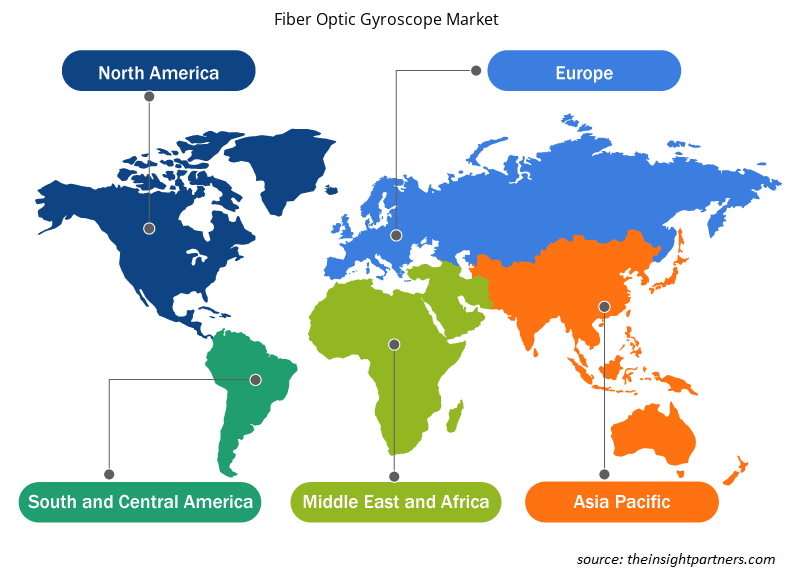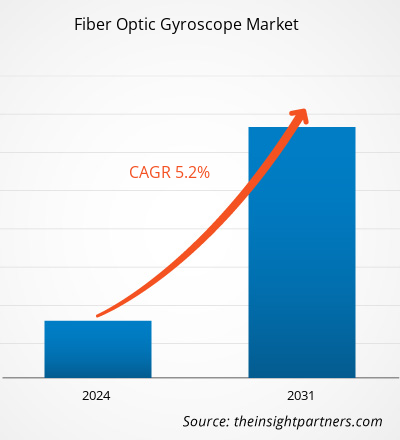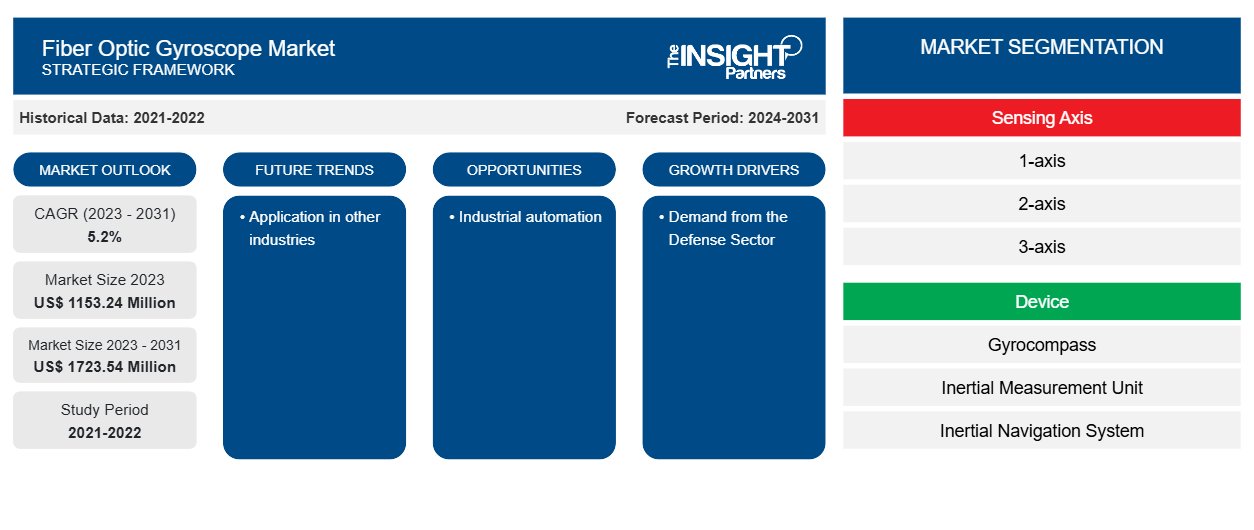La taille du marché des gyroscopes à fibre optique devrait atteindre 1 723,54 millions USD d'ici 2031, contre 1 153,24 millions USD en 2023. Le marché devrait enregistrer un TCAC de 5,2 % en 2023-2031. L'augmentation des dépenses militaires et les avantages offerts par les gyroscopes à fibre optique devraient rester les principales tendances du marché des gyroscopes à fibre optique.
Analyse du marché des gyroscopes à fibre optique
En raison des nombreux avantages des gyroscopes à fibre optique, tels que leur petite taille, leur légèreté, leur faible consommation d'énergie, leur longue durée de vie, leur grande fiabilité et leur production en série, divers secteurs tels que l'aérospatiale et la défense, les secteurs industriels et autres exigent des gyroscopes à fibre optique. Ainsi, les demandes de divers secteurs favorisent la croissance de son marché. En outre, la croissance des dépenses militaires dans le monde en raison de l'accent mis par le gouvernement sur le renforcement de son secteur militaire alimente la demande de gyroscopes à fibre optique dans les applications de guidage de véhicules télécommandés.
Aperçu du marché des gyroscopes à fibre optique
Un gyroscope à fibre optique est utilisé pour mesurer la vitesse angulaire, qui est utilisée dans diverses applications allant de la navigation de missiles au contrôle de mouvement. Les gyroscopes à fibre optique présentent plusieurs avantages par rapport aux autres types de gyroscopes, notamment leur légèreté, leur petite taille, leur longue durée de vie, leur faible consommation d'énergie, leur grande fiabilité et leur production en série. Pour la navigation, le guidage et le contrôle des missiles, des avions, des robots, des voitures, des engins spatiaux, etc., c'est un outil particulièrement important.
Personnalisez ce rapport en fonction de vos besoins
Vous bénéficierez d'une personnalisation gratuite de n'importe quel rapport, y compris de certaines parties de ce rapport, d'une analyse au niveau des pays, d'un pack de données Excel, ainsi que de superbes offres et réductions pour les start-ups et les universités.
-
Obtenez les principales tendances clés du marché de ce rapport.Cet échantillon GRATUIT comprendra une analyse de données, allant des tendances du marché aux estimations et prévisions.
Facteurs moteurs et opportunités du marché des gyroscopes à fibre optique
La demande du secteur de la défense par les acteurs du marché pour favoriser le marché
Plusieurs avantages des gyroscopes à fibre optique, notamment une vitesse de rotation élevée et une résolution élevée par rapport à leurs substituts, tels que les gyroscopes mécaniques et les gyroscopes laser annulaires, favorisent leur adoption dans le secteur de la défense. En raison de ses avantages, les acteurs du marché reçoivent des commandes qui stimulent le marché des gyroscopes à fibre optique. Par exemple, en août 2021, KVH Industries, Inc. (Nasdaq : KVHI), a annoncé avoir reçu une commande de gyroscopes à fibre optique (FOG) de 7,9 millions de dollars américains de la part d'Escribano, un sous-traitant espagnol de la défense, pour sa nouvelle tourelle télécommandée Guardian 30.
Application dans d’autres industries – Une opportunité sur le marché des gyroscopes à fibre optique
Les gyroscopes à fibre optique ont été développés à l'origine pour des applications militaires et de défense. Cependant, en raison de leurs avantages potentiels par rapport aux autres types de gyroscopes, ils sont également largement adoptés dans d'autres industries, notamment dans les secteurs commercial et industriel du monde entier. Il existe également une demande rapide de gyroscopes à fibre optique dans les secteurs de l'automobile, de la médecine et de la robotique. La demande croissante de solutions technologiquement avancées pour améliorer l'efficacité opérationnelle dans plusieurs industries et la tendance croissante à l'automatisation industrielle propulsent encore davantage la demande de gyroscopes à fibre optique.
Analyse de segmentation du rapport sur le marché des gyroscopes à fibre optique
Les segments clés qui ont contribué à la dérivation de l’analyse du marché des gyroscopes à fibre optique sont l’axe de détection, l’appareil et l’application.
- En fonction de l'axe de détection, le marché est segmenté en 1 axe, 2 axes et 3 axes. Le segment 3 axes détenait une part de marché plus importante en 2023.
- Par appareil, le marché est segmenté en gyrocompas, unité de mesure inertielle, système de navigation inertielle et système de référence de cap d'attitude. Le segment des unités de mesure inertielle détenait la plus grande part du marché en 2023.
- En termes d'application, le marché est segmenté en applications de qualité tactique, guidage de véhicules télécommandés, aéronautique et aviation, robotique et défense et sécurité intérieure. Le segment de la défense et de la sécurité intérieure détenait la plus grande part du marché en 2023.
Analyse des parts de marché des gyroscopes à fibre optique par géographie
La portée géographique du rapport sur le marché des gyroscopes à fibre optique est principalement divisée en cinq régions : Amérique du Nord, Asie-Pacifique, Europe, Moyen-Orient et Afrique, et Amérique du Sud/Amérique du Sud et centrale.
En termes de revenus, l'Amérique du Nord représentait la plus grande part de marché des gyroscopes à fibre optique en 2023. La région Asie-Pacifique devrait croître avec le TCAC le plus élevé au cours de la période de prévision.
Le besoin constant de nouvelles technologies pour les opérations de combat et non-combat des forces de défense stimule les dépenses de défense en Amérique du Nord. Selon l'Institut international de recherche sur la paix de Stockholm (SIPRI), les dépenses militaires des États-Unis, premier pays au monde en matière de dépenses militaires, ont atteint 877 milliards de dollars en 2022, soit 39 % des dépenses militaires mondiales totales et trois fois plus que le montant dépensé par la Chine, deuxième pays au monde en matière de dépenses militaires. Ces dépenses militaires entraînent une demande de technologie avancée pour des systèmes de navigation fiables et précis dans les avions et les missiles, ce qui nécessite en outre des gyroscopes à fibre optique car ils offrent une meilleure précision.
Aperçu régional du marché des gyroscopes à fibre optique
Les tendances régionales et les facteurs influençant le marché des gyroscopes à fibre optique tout au long de la période de prévision ont été expliqués en détail par les analystes d’Insight Partners. Cette section traite également des segments et de la géographie du marché des gyroscopes à fibre optique en Amérique du Nord, en Europe, en Asie-Pacifique, au Moyen-Orient et en Afrique, ainsi qu’en Amérique du Sud et en Amérique centrale.

- Obtenez les données régionales spécifiques au marché des gyroscopes à fibre optique
Portée du rapport sur le marché des gyroscopes à fibre optique
| Attribut de rapport | Détails |
|---|---|
| Taille du marché en 2023 | 1 153,24 millions de dollars américains |
| Taille du marché d'ici 2031 | 1 723,54 millions de dollars américains |
| Taux de croissance annuel composé mondial (2023-2031) | 5,2% |
| Données historiques | 2021-2022 |
| Période de prévision | 2024-2031 |
| Segments couverts |
Par axe de détection
|
| Régions et pays couverts |
Amérique du Nord
|
| Leaders du marché et profils d'entreprises clés |
|
Densité des acteurs du marché des gyroscopes à fibre optique : comprendre son impact sur la dynamique commerciale
Le marché des gyroscopes à fibre optique connaît une croissance rapide, tirée par la demande croissante des utilisateurs finaux en raison de facteurs tels que l'évolution des préférences des consommateurs, les avancées technologiques et une plus grande sensibilisation aux avantages du produit. À mesure que la demande augmente, les entreprises élargissent leurs offres, innovent pour répondre aux besoins des consommateurs et capitalisent sur les tendances émergentes, ce qui alimente davantage la croissance du marché.
La densité des acteurs du marché fait référence à la répartition des entreprises ou des sociétés opérant sur un marché ou un secteur particulier. Elle indique le nombre de concurrents (acteurs du marché) présents sur un marché donné par rapport à sa taille ou à sa valeur marchande totale.
Les principales entreprises opérant sur le marché des gyroscopes à fibre optique sont :
- Navigation avancée
- Cielo Inertial Solutions Ltd.
- iXblue
- Société Emcore
- Physoptique
- Honeywell International Inc
Avis de non-responsabilité : les sociétés répertoriées ci-dessus ne sont pas classées dans un ordre particulier.

- Obtenez un aperçu des principaux acteurs du marché des gyroscopes à fibre optique
Actualités et développements récents du marché des gyroscopes à fibre optique
Le marché des gyroscopes à fibre optique est évalué en collectant des données qualitatives et quantitatives après des recherches primaires et secondaires, qui comprennent des publications d'entreprise importantes, des données d'association et des bases de données. Voici une liste des évolutions du marché :
- En janvier 2024, Advanced Navigation a annoncé sa nouvelle gamme de systèmes de navigation inertielle (INS) à gyroscope à fibre optique, Boreas. Le Boreas est un INS de très haute précision et de qualité stratégique, offrant une réduction de 40 % de la taille, du poids, de la puissance et du coût par rapport aux systèmes concurrents. Boreas est le premier produit à être commercialisé basé sur la nouvelle technologie DFOG (Digital Fibre Optic Gyroscope) d'Advanced Navigation, qui est l'aboutissement de 25 années de développement impliquant deux institutions de recherche. Le Boreas est destiné aux applications nécessitant une orientation et une navigation toujours disponibles et de très haute précision, notamment la marine, l'arpentage, le sous-marin, l'aérospatiale, la robotique et l'espace. (Source : Advanced Navigation, communiqué de presse, 2024)
- En septembre 2021, les équipes d’iXblue ont annoncé le lancement de la série UmiX. Cette gamme de centrales inertielles (IMU) de pointe est basée sur la technologie des gyroscopes à fibre optique (FOG). (Source : iXblue, Communiqué de presse, 2021)
Rapport sur le marché des gyroscopes à fibre optique : couverture et livrables
Le rapport « Taille et prévisions du marché des gyroscopes à fibre optique (2021-2031) » fournit une analyse détaillée du marché couvrant les domaines ci-dessous :
- Taille du marché et prévisions aux niveaux mondial, régional et national pour tous les segments de marché clés couverts par le périmètre
- Dynamique du marché, comme les facteurs moteurs, les contraintes et les opportunités clés
- Principales tendances futures
- Analyse détaillée des cinq forces de PEST/Porter et SWOT
- Analyse du marché mondial et régional couvrant les principales tendances du marché, les principaux acteurs, les réglementations et les développements récents du marché
- Analyse du paysage industriel et de la concurrence couvrant la concentration du marché, l'analyse de la carte thermique, les principaux acteurs et les développements récents
- Profils d'entreprise détaillés
- Analyse historique (2 ans), année de base, prévision (7 ans) avec TCAC
- Analyse PEST et SWOT
- Taille du marché Valeur / Volume - Mondial, Régional, Pays
- Industrie et paysage concurrentiel
- Ensemble de données Excel
Rapports récents
Rapports connexes
Témoignages
Raison d'acheter
- Prise de décision éclairée
- Compréhension de la dynamique du marché
- Analyse concurrentielle
- Connaissances clients
- Prévisions de marché
- Atténuation des risques
- Planification stratégique
- Justification des investissements
- Identification des marchés émergents
- Amélioration des stratégies marketing
- Amélioration de l'efficacité opérationnelle
- Alignement sur les tendances réglementaires























 Obtenez un échantillon gratuit pour - Marché des gyroscopes à fibre optique
Obtenez un échantillon gratuit pour - Marché des gyroscopes à fibre optique